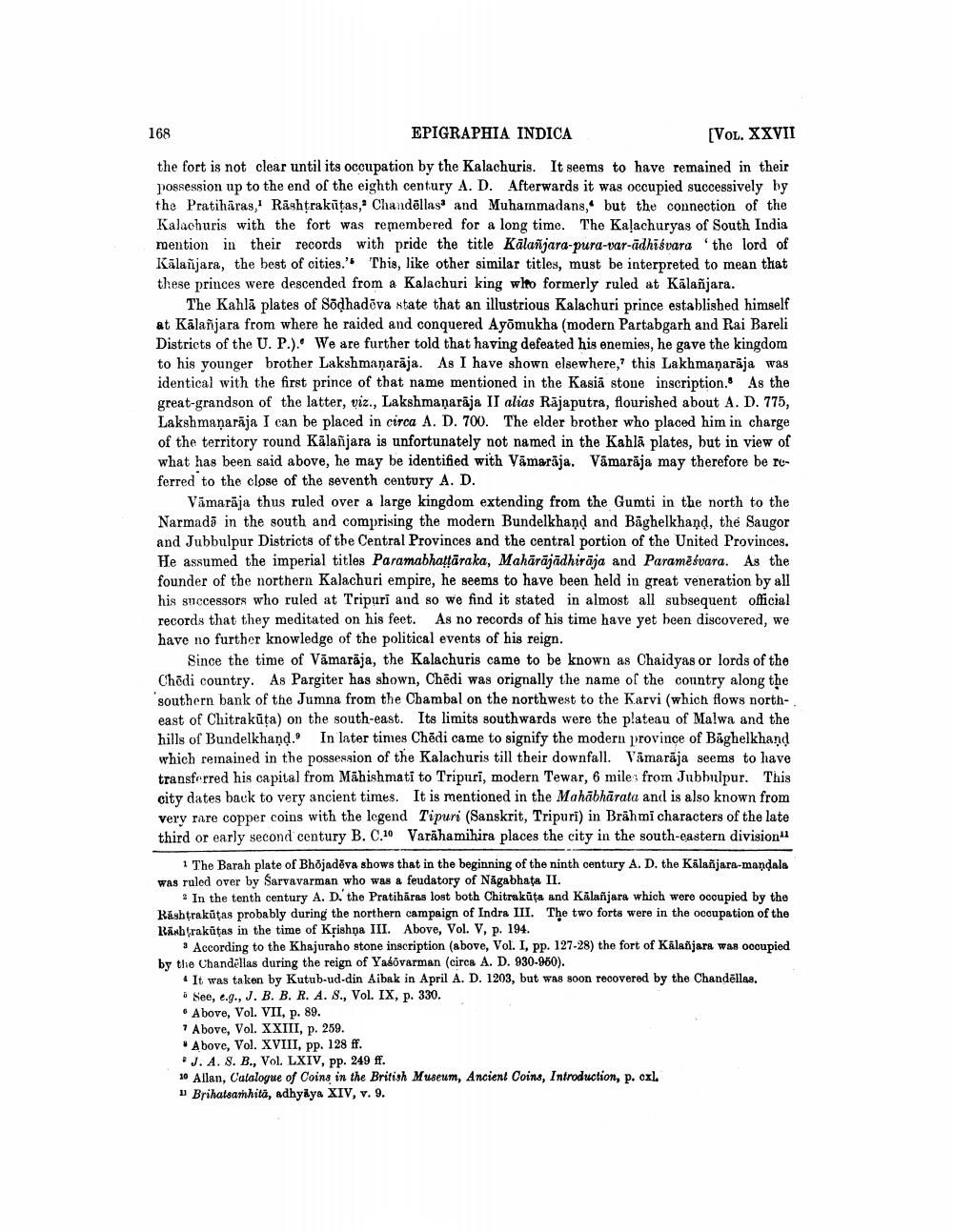________________
168
EPIGRAPHIA INDICA
(VOL. XXVII
the fort is not clear until its occupation by the Kalachuris. It seems to have remained in their possession up to the end of the eighth century A. D. Afterwards it was occupied successively by the Pratihāras, Rashtrakūtas, Chandēllas and Muhammadans, but the connection of the Kalachuris with the fort was remembered for a long time. The Kalachuryas of South India mention in their records with pride the title Kälañjara-pura-var-ādhisvara 'the lord of Kālajara, the best of cities.' 'This, like other similar titles, must be interpreted to mean that these princes were descended from a Kalachuri king wito formerly ruled at Kälañjara.
The Kahlā plates of Sodhadova state that an illustrious Kalachuri prince established himself at Kālañjara from where he raided and conquered Ayõmukha (modern Partabgarh and Rai Bareli Districts of the U. P.). We are further told that having defeated his enemies, he gave the kingdom to his younger brother Lakshmanarāja. As I have shown elsewhere, this Lakhmanarāja was identical with the first prince of that name mentioned in the Kasia stone inscription. As the great-grandson of the latter, viz., Lakshmanarāja II alias Rajaputra, flourished about A. D. 775, Lakshmanarāja I can be placed in circa A. D. 700. The elder brother who placed him in charge of the territory round Kälañjara is unfortunately not named in the Kahlā plates, but in view of what has been said above, he may be identified with Vāmarāja. Vāmarāja may therefore be referred to the close of the seventh century A. D.
Vāmarāja thus ruled over a large kingdom extending from the Gumti in the north to the Narmadā in the south and comprising the modern Bundelkhand and Baghelkhand, the Saugor and Jubbulpur Districts of the Central Provinces and the central portion of the United Provinces. He assumed the imperial titles Paramabhattāraka, Mahārājādhirāja and Paramēsvara. As the founder of the northern Kalachuri empire, he seems to have been held in great veneration by all his successors who ruled at Tripuri and so we find it stated in almost all subsequent official records that they meditated on his feet. As no records of his time have yet been discovered, we have no further knowledge of the political events of his reign.
Since the time of Vămarāja, the Kalachuris came to be known as Chaidyas or lords of the Chodi country. As Pargiter has shown, Chēdi was orignally the name of the country along the southern bank of the Jumna from the Chambal on the northwest to the Karvi (which flows northeast of Chitrakūta) on the south-east. Its limits southwards were the plateau of Malwa and the hills of Bundelkhand. In later times Chēdi came to signify the modern province of Baghelkhand which remained in the possession of the Kalachuris till their downfall. Vämarāja seems to have transferred his capital from Māhishmati to Tripuri, modern Tewar, 6 mile: from Jubbulpur. This city dates back to very ancient times. It is mentioned in the Mahabharata and is also known from very rare copper coins with the legend Tipuri (Sanskrit, Tripuri) in Brähmi characters of the late third or early second century B. C.10 Varahamihira places the city in the south-eastern division
1 The Barah plate of Bhõjadēva shows that in the beginning of the ninth century A. D. the Kālañjara-mandala was ruled over by Sarvavarman who was a feudatory of NÄgabhata II.
* In the tenth century A. D. the Pratihāras lost both Chitrakūta and Kalañjara which were occupied by the Rashtrakūtas probably during the northern campaign of Indra III. The two forts were in the occupation of the Rashtrakūtas in the time of Krishna III. Above, Vol. V, p. 194.
According to the Khajuraho stone inscription (above, Vol. I, pp. 127-28) the fort of Kālañjara was occupied by the Chandellas during the reign of Yaśövarman (circa A. D. 930-950).
4 It was taken by Kutub-ud-din Aibak in April A. D. 1203, but was soon recovered by the Chandellas.
See, e.g., J. B. B. R. A. S., Vol. IX, p. 330. . Above, Vol. VII, p. 89.
Above, Vol. XXIII, p. 259. . Above, Vol. XVIII, pp. 128 ff. .J. A. S. B., Vol. LXIV, PP. 249 ff. 10 Allan, Catalogue of Coins in the British Museum, Ancient Coins, Introduction, p. cxl. 1 Brihatsamhita, adhyaya XIV, v. 9.




